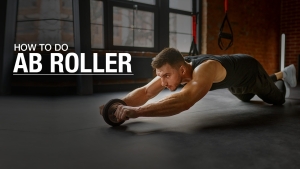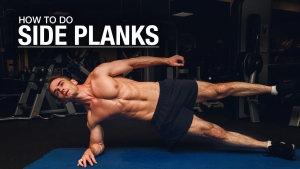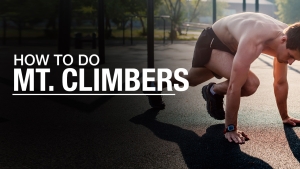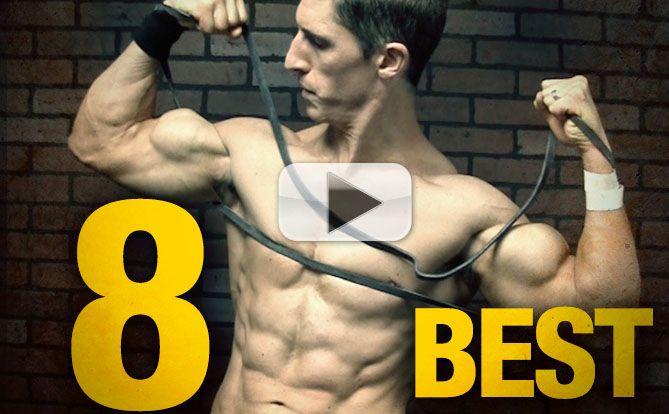
RESISTANCE BANDS TO BUILD MUSCLE
Let me introduce you to our weapon of mass construction, the closed loop resistance band.
You may be like a lot of people who hold the misconception that there’s no way that you can build muscle mass with bands.
That might be true for a strength training routine in which you’ll need the big exercises to build the big muscles, but bands are the perfect tool to train the small muscles that support those big muscles.
When we think of building muscle, we most often consider the larger muscles. I’d like to expand your thinking. Dedicated resistance band training for the smaller support muscles can accelerate your gains for larger muscle groups.
Today I’m going to show you the eight best exercises you should start doing now if you want to increase the weight that you lift on your bigger exercises. You’ll do that by paying some attention to those often-overlooked support muscles.
1) BAND PULL APARTS
The Band Pull-Apart targets the shoulder girdle, and that’s important to building stability for your chest presses.
The big pressing movements like the bench press depend on your shoulder blades staying in proper position, and the rhomboids are the supporting muscles that help do that. This exercise strengthens the rhomboids.
This exercise will be helpful for anybody that has any kind of scapular instability like “winging” of the scapula, where the scapulae start to come off your back. It’s called winging because the middle portion of the scapula can’t stay fixed onto your back, creating the look that you have tiny wings sprouting out of your back.


2) SERRATUS PUNCHES
Weak serratus muscles can also cause shoulder blade instability and limit your ability to press heavy loads.
Use the Serratus Punch to work these important shoulder stabilizers.
The serratus muscles pull your shoulder blades forward and help hold them tight against your rib cage. (The serratus also creates those nice “serrated” lines to the outside of your pecs when you’re really lean. So, there’s a second good reason to get them in shape.)
It’s important that your shoulder blades maintain stability and stay in contact against your ribcage, even if they’re rotated up or down especially for heavy pressing movements. Remember, if you’re trying to execute a push with some serious strength behind it, you have to have a stable base to work off of.
To get into the Serratus Punch starting position, fasten your band down and behind you and then face away from it. To do the “punch”, straighten your arm as far as you can and keep the band tight. If you think you’ve reached out as far as you can go, try to reach out even further.
These first two exercises create a strong base to push against when your chest presses get heavy. Work them both for a 1-2 combination.

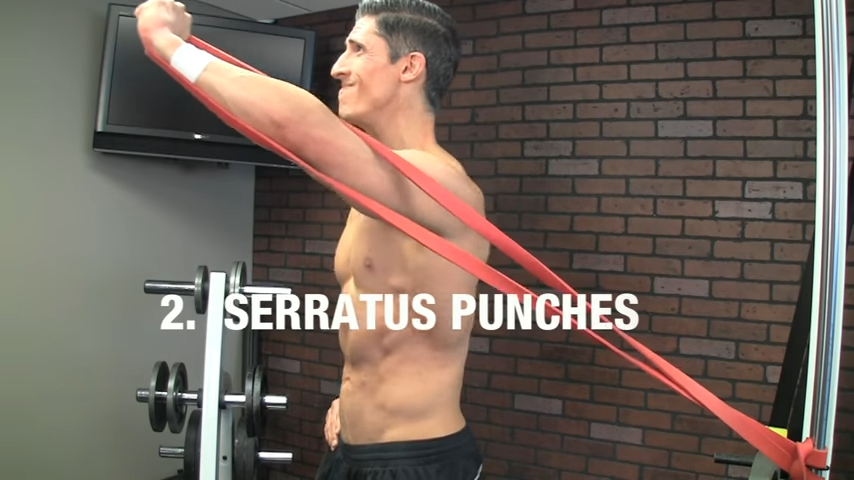
3) OVER AND BACKS
Now, let’s get more dynamic and eccentrically work the rhomboids and serratus with the Over and Back.
Just like the name suggests, you’ll be passing the band over your head and behind you and then back again.
To do the Over and Back, stretch the band in front of you, band around wrists and between your outstretched arms, then raise your arms up and over your head while keeping the band taut. Maintain tension on the band the entire time.
Once your arms are behind you at mid-back level, bring the stretched band back over your head to the front again.
Don’t allow it to snap back in front too quickly, and keep away from your body through the entire exercise. Control the band from front to back and then back to front without letting it snap to keep your rhomboids under constant tension.

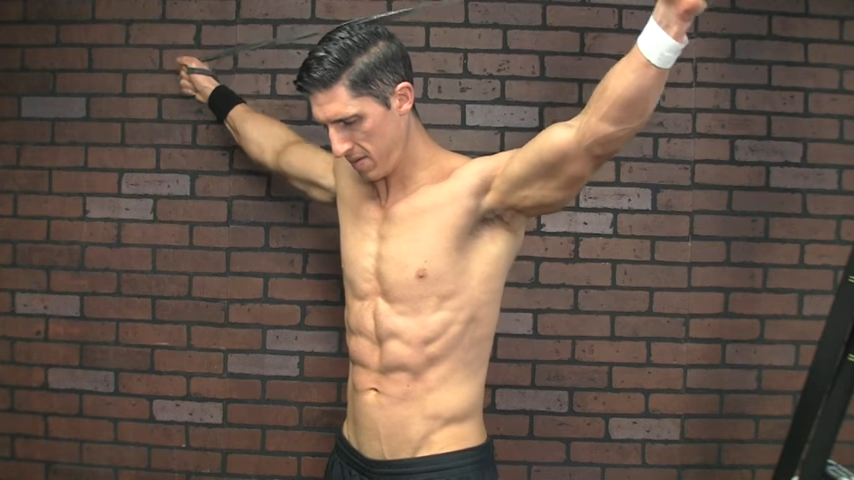
4) OVERHEAD JACKHAMMERS
Most people think of their lower traps as a back muscle, but they’re actually a shoulder muscle, and they’re an essential part of executing a proper and safe bench press.
The lower traps keep your shoulder blades tucked down and back and provide a platform for those heavy presses.
Well-developed, hypertrophied lower traps add thickness and muscular contour to your back. So, in that way, they are a back muscle, aesthetically speaking.
The Overhead Jackhammer works your lower traps. Do them regularly to prevent injury and maximize your pressing gains.

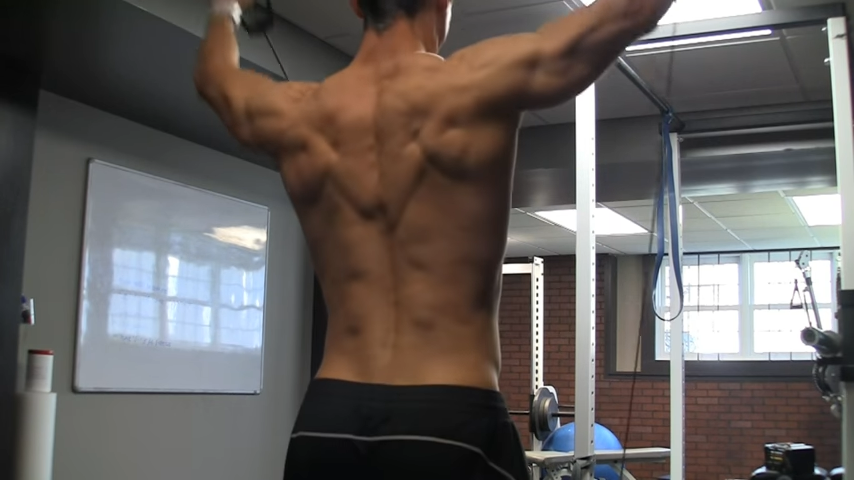
5) BAND FACE PULLS
You can’t watch professional sports for very long without knowing how important the rotator cuff is to athletic performance. The same is true for you.
The rotator cuff contributes to the strength and stability of the entire shoulder joint.
The Band Face Pull is one of my favorite resistance band exercises and works the entire upper back.
The Band Face Pull differs a little from the Cable Face Pull that you guys know I love so much. The big difference is that it loads the end phase of the exercise; it gets more difficult as you stretch the band. So, it goes from relatively easy to more challenging as you pull back.
To do the Band Face Pull, bring your thumbs back so that they point behind you to achieve external rotation of the shoulder. That motion involves three of the four rotator cuff muscles.
Train external shoulder rotation to prevent injury. This exercise is a great way to do that.

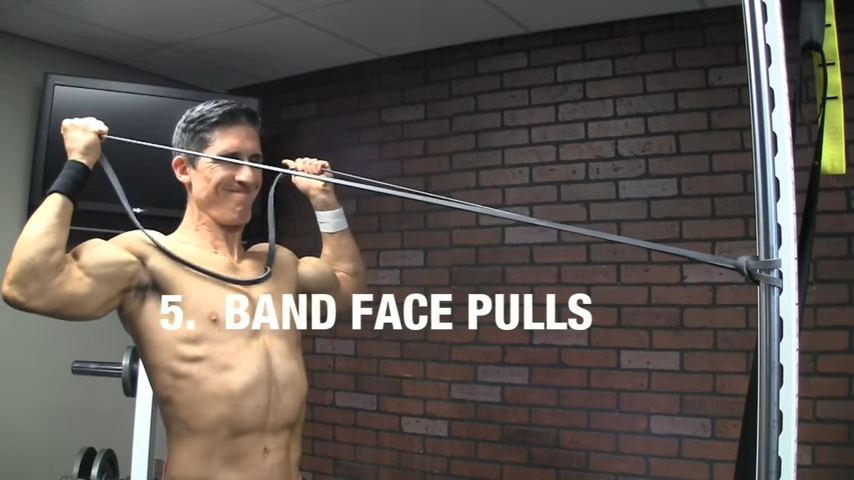
6) RESISTED HIP HINGE
We work our quads. We work our hamstrings. But do we work on the smaller muscles? The hip joint includes more than a dozen muscles that intertwine and must work together.
The smaller hip muscles often don’t get the attention they deserve. You have to work those smaller hip muscles if you want to get the most out of those larger muscles when you’re trying to execute bigger lifts like the squat and deadlift.
To do that, work the hip hinge. You can spare yourself a lot of potential knee problems down the road by learning how to execute a hinge of the hip first before training heavy squats and deadlifts.
Hip hinges are traditionally done with barbells or dumbbells through exercises like the Romanian Deadlift (aka RDL). You can strengthen the traditional hip hinge in a really fundamental way with our hip hinge resistance band exercise.
To do the Band Resisted Hip Hinge, anchor the band around your body. Let the tension pull you back into a familiar hip hinge starting position where your hips are behind your feet. Bend at the hips with only a slight bend at the knees. (The knees can flex a bit so that your legs aren’t perfectly straight.)
Use your glutes to press your hips forward and squeeze the glute muscles to slowly control the eccentric phase of the exercise as you lower back down into the hinge.
This is one of the great resistance band exercises to learn to strengthen the mechanics of the hip hinge motion.

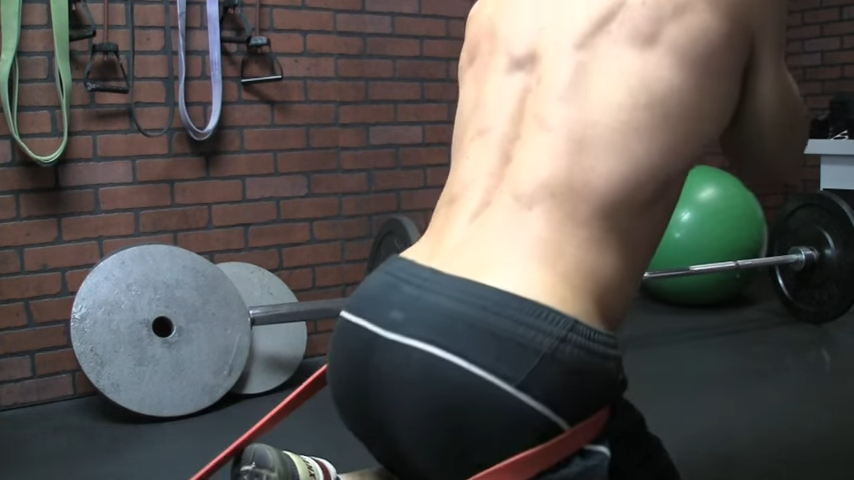
7) OVERHEAD SIDE STEPS
The ability to strongly abduct the hips is critically important to increasing the strength of all your lower body exercises. Overhead Side Steps are one way to do that.
You’re probably familiar with the banded side step with the closed loop resistance band wrapped around your knees to create resisted hip abduction. The Overhead Side Step adds resistance to thoracic extension, so we also get core work in the process.
To do the Overhead Side Step, step into the band with the band underneath your feet and your feet hip width apart. Stand tall, and cross the band overhead spreading your feet and arms as far as you can against the resistance of the band to form a letter X across your entire body.
Step out to the side with a controlled motion and then follow with the trailing leg using the same slow, controlled movement. The foot should always land flat.
Depending on the strength of the resistance bands, you may only be able to step sideways a couple of inches.
The Overhead Side Step works both the upper body and lower body.
You’ll be amazed at how weak we are in our hips in the ability to abduct.
There are elite level athletes that can’t even lay on the ground and execute 25 leg lifts Jane Fonda-style without it burning so bad that they can’t even make it.
The side step range of motion can vary. Basically, you want your foot to move out to the side as far as you’re able to. Exercise form is very important though. You need to keep your entire core tight and step to the side by moving only at the hip joint. One foot follows the other, so step with left foot, plant it, and follow with the right.

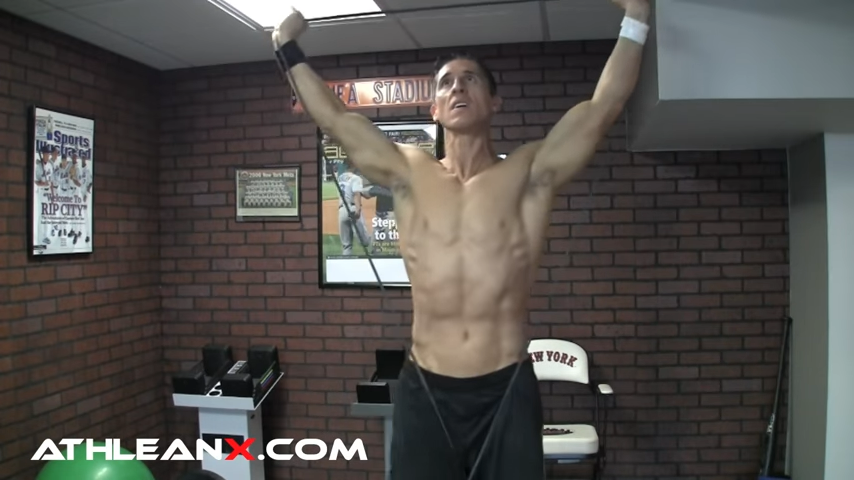
How you move your foot–and foot placement–is vital to doing this exercise correctly. A lot of people–almost everyone in fact–bends at their knee and ankle when stepping to the side.
Do NOT do that. Doing so robs your hip abductors of the work and transfers the stress to the outside of your knee.
All the bend should be at the hip. Move your leg to the side as if your leg was in a brace, keeping your toes pointed forward and the sole of your foot parallel to the floor. You want to land with your feet flat and not on the inner edge of your foot. You don’t need any ankle flexibility to perform this exercise correctly.

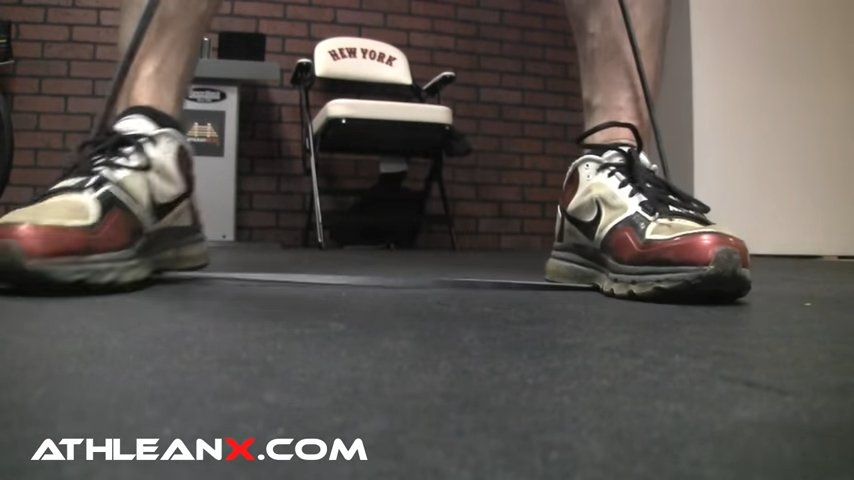
8) OBLIQUE CORKSCREW
Don’t forget your core! We’ve talked about exercises for our hips and shoulders that use elastic bands; the core brings shoulders and hips together.
Our final exercise is the Oblique Corkscrew. It works the obliques and core activation in general.
Everyone likes to focus on their 6-pack abs, but the diagonally running internal-external obliques are more important functionally, especially for trunk rotation.
If you want to get stronger in all your core-related movements, you’d better start working on your obliques.
To do the Oblique Corkscrew, wrap the band around an upright bar on a power rack or fasten it to something else secure that’s above shoulder height and put your upper arm through the loop. Step out to stretch the band, standing with feet shoulder width apart. Tuck your chin to chest, then twist down and to the side, aiming your elbow toward the opposite knee.
You can put the fingers of the opposite hand on those muscles and feel them contract. They’re easy to feel, even if you’re carrying a little bit of body fat.
You can still feel these muscles working and you want to get into the habit of making them work more often. I predict this will become a favorite core exercise for you.

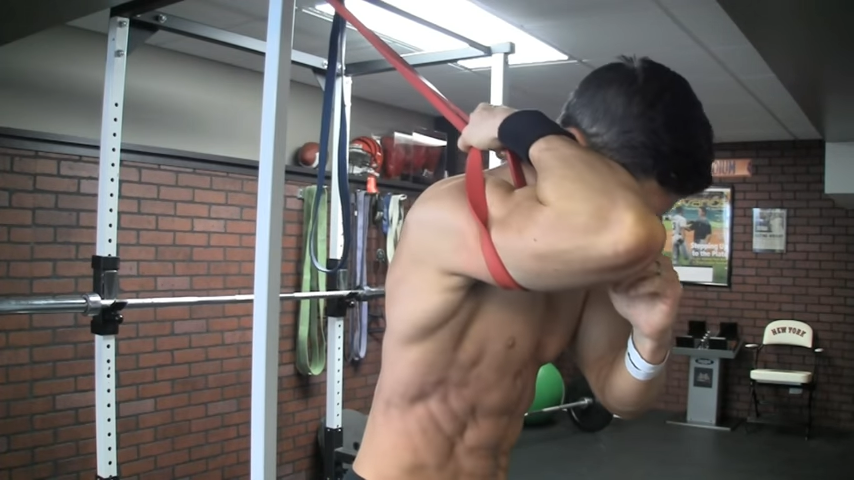
So there you have the 8 best closed loop band exercises you can do, especially if you want to start building mass. There’s an almost endless range of exercises you can do with bands.
I know it’s not that sexy, but if you start adding these exercises to your routines, you’re going to find that those big lifts will take a big jump up because you’ll be working the supporting muscles.
When those smaller muscles are strong, you’ll be amazed at how much power you can generate with the larger muscles that rely on those small muscles.
MORE ABOUT CLOSED LOOP RESISTANCE BANDS
Closed loop resistance bands are one of the two types of elastic bands that have become very popular fitness tools. The other type of elastic band is tubing, which we don’t address here.
Exercise bands are available in a variety of thicknesses and colors, with the colors corresponding to how much work is required to stretch them. Colored bands’ color schemes are not universal; color and thickness relationships vary depending on the manufacturer.
You can start your own set with just a couple of bands and add to them as you get stronger. Check out our ELAST-X line of bands if you don’t already own a set, or if you’d like to build on the set you have now.

- Closed loop bands are sometimes-overlooked fitness tools. They’re available in different thicknesses and colors that correspond to how much tension they generate.
- Bands can be especially helpful in training the smaller, supportive muscles of the larger muscle groups we tend to think of and train more often.
- Stronger support muscles like the rotator cuff, serratus anterior, lower traps, hip abductor, and obliques provide a base of support for heavy lifts and help prevent injury.
- The 8 Best Band Exercises work the shoulder, hip, and core muscles.
- Band Pull-Aparts, Serratus Punches, Over and Backs, Overhead Jackhammers, and Band Face Pulls work on the muscles that support the shoulder.
- Resisted Hip Hinges and Overhead Side Steps target the hip extensor and hip abductor muscles.
- Oblique Corkscrews isolate the internal and external oblique muscles. Overhead Side Steps also work the entire core.
- Do these exercises on off days, add to your existing resistance band workouts, or add them as auxiliary exercises for your heavier workouts.

Jeff Cavaliere M.S.P.T, CSCS
Jeff Cavaliere is a Physical Therapist, Strength Coach and creator of the ATHLEAN-X Training Programs and ATHLEAN-Rx Supplements. He has a Masters in Physical Therapy (MSPT) and has worked as Head Physical Therapist for the New York Mets, as well as training many elite professional athletes in Major League Baseball, NFL, MMA and professional wrestling. His programs produce “next level” achievements in muscle size, strength and performance for professional athletes and anyone looking to build a muscular athletic physique.































